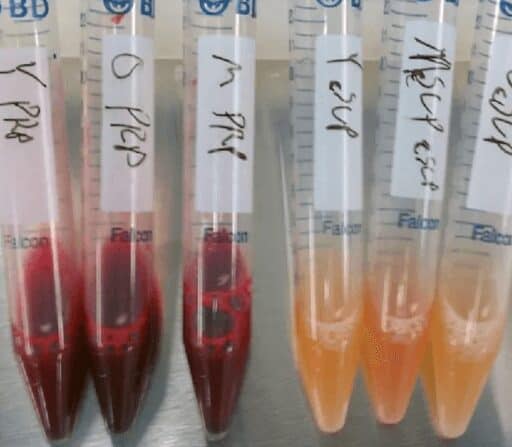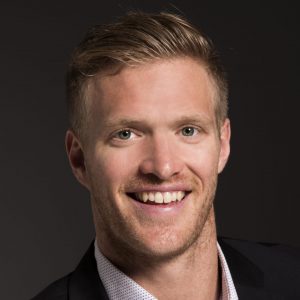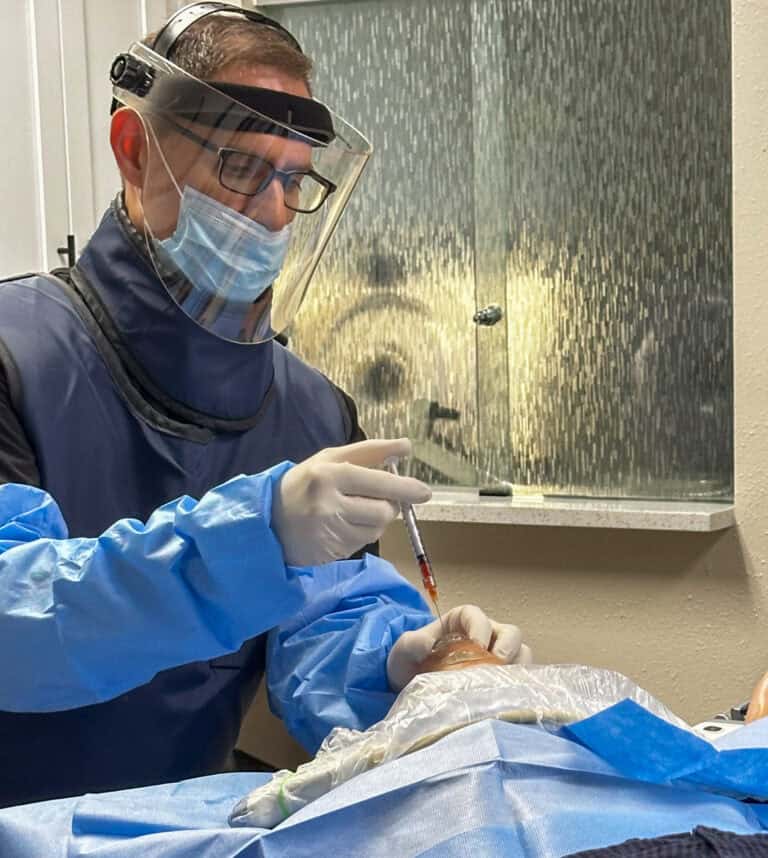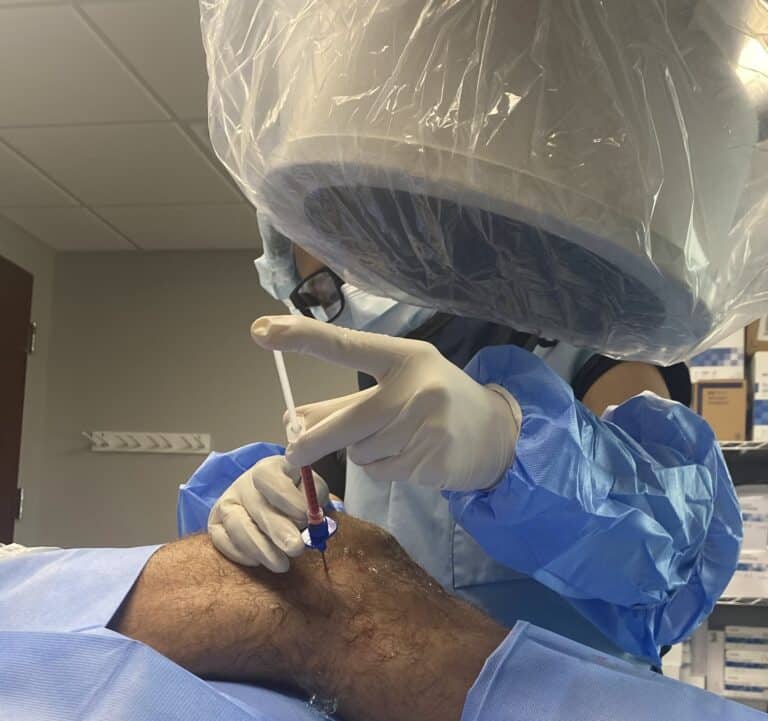PRP became popular and on the map when NFL football player Hines Ward was treated in 2009 with a PRP injection and went on to help his team win the Super Bowl that season.
Since then, athletes, weekend warriors, and average joes have been pursuing these therapies to decrease pain and improve function so they can do what they love to do. This can range from staying in a professional sport for the championship game, running a marathon, or simply being able to play with grandkids.
What is PRP and how does it work?
PRP stands for Platelet Rich Plasma.
When separating blood into its components, there are: red blood cells, white blood cells, platelets, and plasma. Plasma is a golden-yellow substance that makes up over 50% of the blood and is responsible for carrying salt, water and enzymes through the blood while platelets are the substance of the blood responsible for clotting.
The platelets also have growth factors in them, which are instrumental in the healing process. Growth Factors are explained well by Chris Centeno, MD in his article on PRP Therapy Considerations(1):
What are growth factors? Think of growth factors like espresso shots for local repair cells. They stimulate other cells to do more work and can even call the needed repair cells to the area.
Chris Centeno, MD
So, simply, the PRP is plasma that’s full of the growth factors and platelets, but void of red and white blood cells. PRP is obtained from the blood by separating it out and there is an important variation in how clinics will separate PRP from the blood. The most common, yet least specific, way to separate out the PRP is via a simple table-top centrifuge. When a centrifuge is used it is not strong enough or precise enough to get a pure PRP extraction.
Now, when PRP is separated out of the blood in a lab setting, there are stronger machines and processes. This allows for a more specialized means of processing the PRP to account for the few types that are possible in the PRP world.
Types of PRP?
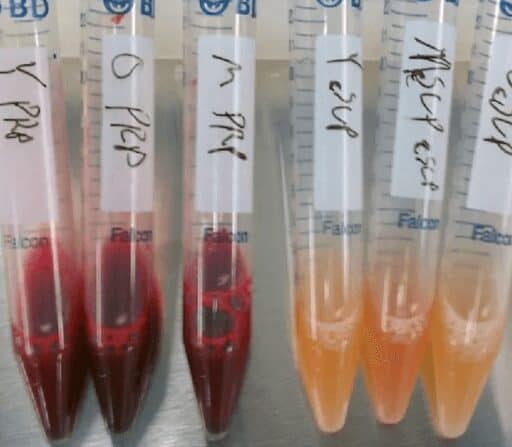
LR- PRP
Leukocyte is the word meaning “blood cells.” So leukocyte-rich denotes a type of PRP that is “rich” in blood cells in addition to the plasma and the platelets. This type of PRP is easy to spot by its red color (see Figure 1).
LP-PRP
Leukocyte-poor means the lab processing of the blood removes as much of the red and white blood cells as possible to make the injected substance mostly plasma and platelets. This yields a golden amber-colored blood product that is distinct from the LR-PRP (see Figure 1).
Concentration: further defines the PRP
The concentration of platelets in PRP is measured from a comparison to the naturally-occurring concentration of platelets in the blood. There are low, medium, and high concentrations of platelets in PRP samples, and they are as follows:
- Low Concentration is 1-3 times (1-3X) the normal concentration of platelets in the blood
- Medium Concentration is 3-7 times (3-7X) the normal concentration of platelets in the blood
- High Concentration is 7-10 times (7-10X) the normal concentration of platelets in the blood
These specific concentrations can only be obtained when the blood is processed in a lab. The lab has the tools and the processes to be this specific, whereas the tabletop centrifuge is not strong enough or precise enough to render the high concentrations of platelets in a PRP sample.
The most common concentration worked within our Regenexx office is a high concentration of 7-10X, which works very well in middle-aged and elderly patients. This is because a higher concentration of platelets means a higher volume of growth factors.
For example; Regenexx at NROFL physicians will ask for Quantity (3cc) of the PRP along with the type (LR vs. LP) and concentration (12x). (ie: 3cc PRP-LR 12x)
This is necessary to give reproducible results when doing procedures on areas in the body.
Which Type of PRP is Effective?
Now, since we have defined two types of PRP, is there research showing which is more effective? There sure is. We will review what the research is saying about the efficacy of LR-PRP versus LP-PRP, and also which joints and tissues do well overall.
LR-PRP (RED PRP)
One lab-based study compared LP-PRP and LR-PRP on the treatment of ACLs(6). The results suggested increased cell-growth in the PRP samples with higher concentrations of blood cells and low concentrations alike, with no discrepancies in tissue breakdown noted in either group. So, both LR-PRP and LP-PRP are favorable in the case of an ACL repair.
Another lab study found the LR-PRP was superior to LP-PRP in the case of cartilage regeneration(5).
LP-PRP (AMBER PRP)
One study sought to evaluate the effect of LR-PRP on synovial cells(3) since the only previous studies evaluated the effects of LR and LP PRPs in cartilage cells. The findings were that LR-PRP with blood cells maintained in the product actually had an injurious effect on the synovial cells leading to excessive inflammation. In the case of treating intra-articularly, the literature supports the use of LP-PRP, in favor of high-level lab processing to ensure blood cells do not remain in the sample.
Another study compared LR-PRP and LP-PRP in the treatment of knee cartilage in patients with knee osteoarthritis. Results showed improved functional outcomes in those treated with LP-PRP, as compared to LR-PRP, hyaluronic acid, and placebo(2).
A different study evaluated the effects of LP-PRP (amber-colored) and LR-PRP (red-colored) on the healing of cartilage(4). This study was performed in-vitro and studied histologically, while the previous study discussed was performed on patients. The results of LR-PRP and LP-PRP were initially comparable, but on day seven of the culture, the LP-PRP demonstrated superior cell growth and proliferation. Conversely, the LR-PRP sample displayed signs of chemical pathways that would ultimately lead to cell breakdown more than cell growth.
Effective Treatments Overview
There are areas and tissues in the body that PRP works very well for, and other areas bone marrow concentrate may be superior. The current research suggests the following body regions can expect positive results when treated with PRP.
- Knee Arthritis
- Tennis Elbow
- Spine
- Achilles Tendon
- Rotator Cuff Partial Tears
Knee Osteoarthritis
A recent study shows that intra-joint PRP injections are effective in treating knee osteoarthritis (7).
Tennis Elbow
In a recent meta-analysis of RCTs comparing PRP and corticosteroid injections for tennis elbow, PRP was found to yield superior results(8).
Spine
PRP injections were found to be more effective when compared to corticosteroid shots in the case of treating low back pain originating from the sacroiliac joint or facet joints(9,10). PRP injections were also found to be helpful in the treatment of pain coming from low back discs(11).
Achilles Tendon
One study shows the support that PRP works for treating Achilles tendon pain(12). Another study actually evaluated a piece of Achilles tendon after treatment and revealed improvement in the tissue structure after PRP as compared to the control(13).
Rotator Cuff Partial Tears
This recent article we wrote gives an overview of a recent randomized control trial showing PRP has superior results over corticosteroids for partial rotator cuff tears (14).
How Can you Maximize the benefits of PRP?
A common question we get is: will the effects of my PRP treatment be permanent?
Well, the answer to that question varies. The main variables are:
- The nature of the tissue being treated
- Patient habits
When it comes to the nature of the tissue being treated, it makes a difference if PRP is treating bone, like knee arthritis, or tissue, like a partial tendon tear. Pain from osteoarthritis can be significantly improved, but the bone may remain stiff or ugly on X-Ray. Conversely, we have studies showing changes in tendon injections because we know there is actual tissue tear healing that can take place.
So, that’s where the patient habits come in. Sometimes patients need more than one injection in an arthritic joint, to keep the growth factors and healing in the joint rather than inflammation and degeneration. Also, we usually recommend physical therapy after PRP injections. When working with a therapist, it helps the patient strengthen or mobilize after a PRP injection, but it also can help patients learn how to change mechanics that would worsen the arthritic condition and prevent long-term relief.
A patient should also consider supplements and other lifestyle factors to keep systemic inflammation down. At Regenexx at NROFL we keep the whole patient in mind in end-to-end support for a procedure. We include instructions to prepare your body for the procedure, and recover best from it so you can achieve the best lasting results.
The main takeaway is that PRP is an amazing tool to help with a variety of pain conditions, based on how it’s processed and administered. This is another reminder from Regenexx at NROFL on how important it is for you to do your research to advocate for yourself when seeking clinicians to help you heal your joints or tissues.
References
- https://regenexx.com/blog/prp-injection/#gref
- https://pubmed.ncbi.nlm.nih.gov/25925602/
- https://www.ncbi.nlm.nih.gov/pmc/articles/PMC5878923/
- https://pubmed.ncbi.nlm.nih.gov/24599205/
- https://pubmed.ncbi.nlm.nih.gov/29125811/
- https://pubmed.ncbi.nlm.nih.gov/28485509/
- https://pubmed.ncbi.nlm.nih.gov/29210206/
- https://pubmed.ncbi.nlm.nih.gov/31128316/
- https://pubmed.ncbi.nlm.nih.gov/27677100/
- https://pubmed.ncbi.nlm.nih.gov/27989008/
- https://pubmed.ncbi.nlm.nih.gov/27073034/
- https://pubmed.ncbi.nlm.nih.gov/30937491/
- https://pubmed.ncbi.nlm.nih.gov/26312841/
- https://newregenortho.com/rct-shows-prp-has-superior-results-over-corticosteroids-for-shoulder-pain/
